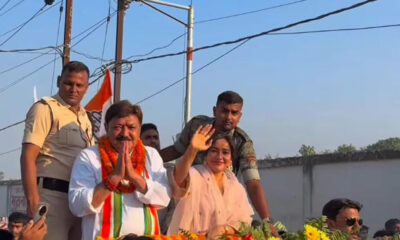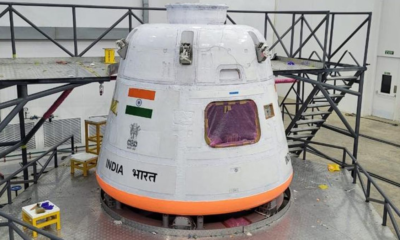Know the meaning of Aarti, Jai Adyashakti…. written by Sivananda Vamdev Pandya on the banks of Narmada 421 years ago.
KEY POINTS :
- The description of Mataji appearing to Swami Sivananda is in the fourth line
- Swami Sivananda, who lived in Mandwa Buzurg village near Bharuch, later settled in Surat.
- Over time, Aarti’s lines kept changing, and there were also mispronunciations.
Mataji is installed. The chandelier is lit. The light is shining. Five lamps are lit on a plate full of flowers, abil, gulal. Drums, manjira, zalar and ghantarav begin. Mataji’s Aarti begins to be recited … ‘Jai Adyashakti … Maa Jai Adyashakti …’ When Mataji’s Aarti is going on, there is a different kind of joy and peace in the group saying ‘Jai Om Jai Om Maa Jagdambe …’. When this Aarti of Mataji is sung in Navratri, different waves flow in the air. Divinity is realized.
When we sing this Aarti Bhava, some devotees ask, who wrote this Aarti? When to write, Why write And why did this arti become so popular all over the world? So come, let us know the meaning of Ambeni Aarti …

Who wrote Aarti?
Vamdev Pandya, alias Swami Sivananda writes this Aarti Sivananda. Mandwa Buzurg is a village on the banks of river Narmada between Bharuch and Ankleshwar. The village has an ashram of Markand Muni and an ancient temple of Goddess Ambaji.
Swami Sivananda’s ancestors used to take care and worship in this ashram and temple. Vamdev Pandya’s brother Sadashiv Pandya served Goddess Ambaji for life. Taking inspiration from uncle Sadashiv, Sivananda turned to the path of devotion. Thus, Sivananda Pandya became famous as ‘Swami Sivananda’. This Aarti was composed by Swami Sivananda 421 years ago.
Swami Sivananda’s uncle Sadashiv was a scholar.
Swami Sivananda’s uncle Sadashiv had such folklore that he did not know anything until he was 35 years old. Then Sadashiv Pandya, fed up with Mahena, started worshipping at the Ramnath Ghela temple on the banks of the Narmada.
At that time, one day, a saint came there and was pleased with the devotion of Sadashiv and gave blessings. As a result, Saraswati settled on his tongue. He composed texts in Sanskrit and achieved success in Mantra-Tantra Vidya.
Do you want Lakshmi or Saraswati?
When Sadashiv was on the verge of death, he called his two sons and nephew Sivananda and asked, “Do you want Lakshmi or Saraswati?” His two sons asked for Lakshmi, but Sivananda said, give me what you think is right.
Pleased to hear this, uncle Sadashiv preached the Panchakshari mantra to his nephew Sivananda and said he would be famous. So may you keep praising the path of devotion and keep worshipping our Ramnath Isht. Sivananda accepted the order and worshipped Shiva, and also recited Bhagavatakathas.

Uncle, like nephew, also became a scholar
uncle Sadaashiv Swami Sivananda was a scholar like Pandya. Sivananda was a Vidhan Shastri. His erudition was considered equal to that of Kashi. Running a school at his residence for the study of theology, jurisprudence, Puranas and Shrotakarma.
He even composed the Aarti of Adyashakti Ambaji Mata. Apart from that, he composed literature in Sanskrit, Hindi and Gujarati such as Shiva Stuti, Dhol, Vasant Puja, Hindola, Padna Samayan Pad.

Thus found the inspiration to write Aarti.
An ancient temple of Goddess Amba on the banks of Narmada.
Swami Sivananda was born in the house of Vamdev Harihar Pandya in 1541 in Nagar Phalia on Ambaji Road in Surat. Swami Sivananda was raised by his uncle Sadashiv Pandya after his father’s death at an early age.
Once when Swami Sivananda was going to Mandwa Buzurg in the old village of his ancestors to pay homage to Mother Lakshmi in Khambhat, he was inspired to compose an Aarti of Jagdamba. The year was 1601.
At that time, Swami Sivananda was 60 years old. One evening he was meditating on the banks of the river Narmada near the temple of Goddess Amba. The red sun was setting as if Madi’s conch was falling from the sky … At the same time, Lakshmi appeared in the south direction with four arms. Overwhelmed by this vision, Swami Sivananda created Aarti on the banks of the river Narmada.

Expanded meaning including the line of Jya Adyashakti Aarti in Jya
Adyashakti Jai Adyashakti, Akhand Brahmand Nipavya, Padve Pragatya Ma,
Om Jai Ho Jai Ho Ma Jagdambe …
Meaning: Adya means the first world, world or an unbroken egg-shaped universe. Shakti became the cause, and that day was also said to be the first day of Brahma. Jai ho jagdamba in such a unique form.
Know the second bay from Shivshakti, Brahma Ganapati sings, Har Gaye Har maa
meaning: Two forms mean man and nature, Shiva and Shakti are both your forms. O Mother, Brahma, Ganapati and Shiva sing your glory.
The third three forms sat in Tribhuvan, swimming through the three, you in swimming.
Meaning: The three forms are Mahasaraswati, Mahalakshmi and Mahakali. You are sitting on the three Bhuvan abyss, the sky and the earth. You are the triune confluence of Ganga, Yamuna and Saraswati and knowledge, devotion and salvation.
In the fourth Chatura Mahalakshmi, Sacharachar pervaded Charbhuja Chahu Disha, Pragatyan in the South.
Meaning: Mahalakshmi is considered to be the most clever. Mahalakshmi pervades Sacharachar in various forms. Their quadrilaterals are equal in four directions, and they have appeared in the south to bless.
Panchami Panch Rishi Panchami Guna Padma, Panch Sahastra Tya Sohiye, Panche Tattvo
Mein Artha: With the blessings of Jagdamba, compassion, love, truth, Sattva and Mamtva, these five Guna are obtained. Even the five great sages, sitting on the lotus, have sung your praises. O Mother, you are saturating the five elements earth, water, sky, light and air.
Sixth, you killed Narayani, Mahishasur, in the form of men and women, pervading everywhere.
.
Saptami Sapt Patal Savitri Sandhya;
Meaning in Gau, Ganga, Gayatri, Gauri, Gita: You are sitting in the seventh abyss, Savitri (morning) and Sandhya. The five mother forms are Gai, Ganga, Gayatri, Gauri (Parvati) and Gita.
Ashtami Asht Bhuja I Ananda, Sunivar Munivar was born,
meaning in Dev Daityo : (Mahakali who kills demons is considered eight-armed.)
Ninth Nine Clan Nag Seva Navdurga, Navratri Pujan, Shivaratri Archan, Keedha Harbrahma
Meaning: The snakes of the ninth clan burn you and worship Navdurga. You are worshipped on Navratri. You are worshipped with Shiva on Shivaratri. Brahma also praises you.
Tenth ten incarnations Vijayadashami, Ram Ram ramadaya, Ravana rolyo Mother
Earth: shared slaughter Ram Ravan in Dussehra day, so it is called Vijayadashami. O mother, it is by your grace that Rama destroyed Ravana. (It was Amba who gave a bow to Rama to kill Ravana).
Ekadashi Agiyaras Katyayani Kama, Kamadurga, Kalika, Shyamne Rama
Meaning: On the eleventh night of Norata, the glory of Katyayani’s mother is sung. (It is mentioned in Srimad Bhagavatam that Gopis vow to be Katyayani’s mother on the banks of Yamuna to get Lord Krishna as a bridegroom. Katyayani’s favorites get full.)
Shyama means Radha, and Rama means Sita.
Baras balarupa, bahucari AMBA mother, Anger consumed sohiye Bhairava, Bhairava sohiye time, your mother is tooj
means: multivariate mother is believed to be balasvarupe pragatelam Baras day. Batuk Bhairav (Kshetrapal) and Kala Bhairav (Cemetery) are all your servants. Which adorns your side.
Thirteen Tuljarup you sing Tarini Mata, Brahma, Vishnu, Sadashiv, Gunatara
Meaning: O mother, your thirteenth form belongs to Tulja Bhavani. (Tulja Bhavani resides in Kolhapur in Maharashtra, who was the family goddess of Chhatrapati Shivaji.)
The fourteenth form of Chandi Chamunda, give nothing to devotion, give nothing to cleverness, the mother of the lioness
means: The fourteenth form of power belongs to Maa Chamunda. It is situated in fourteen Bhuvans and fourteen Vidyasvarupas. So please give us a little devotion and ingenuity, mother who carries such a lion as a vehicle.
Poonam filled Kumbh, listened to Karuna Maa, Vashishta Deva praised, Markand Muni praised, Gai Shubh Kavita.
Meaning: Poonam means when the moon is in full bloom, listen to our request with compassion in the distance. Sage Vashishta and Markand have sung your glory through many hymns.
Samvat sixteen satavan sixteen in twenty-two, Samvat sixteen lit, Rewane arrow.
Meaning: In the Samvat of 1657, you appeared in the form of a sixteen-year-old virgin
O mother, you are omnipresent. Sixteen thousand gopi forms are also yours. So forgive us if we have made any mistake in worship.
Whoever sings Aarti of Shivshakti, Bhane Sivananda Swami, will have happiness, Har Kailas will go, Maa Amba will lose sorrow Meaning: Whoever sings this Aarti with love will get happiness and wealth.
The happiness of heaven will be found. Sivananda Swami, the creator of Aarti, says that a place will be found in the footsteps of Shivaparvati-Kailas.
Not Adya but Adya, Jayo Nahin Jai Ho!
We sing “Jai Adyashakti, Maa Jai Adyashakti” in Aarti. ‘Adya’ is not a word, but ‘Adya’. While ‘Jayo Jayo Maan Jagdambe’ is distorted. Actually it is – ‘Jai Ho Jai Ho Maan Jagdambe. Thus many devotees later modified this Aarti, and some even added new verses. So some rows come across us incorrectly. However, ‘Adya’ is sitting in the song, and Jai ૐ or Jai Ho … is also sung.



























